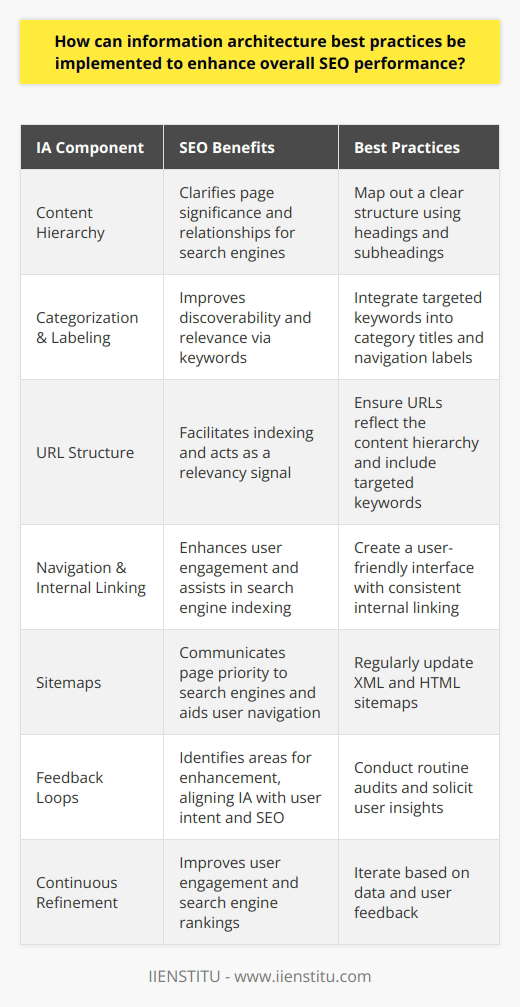
This article discusses the importance of information architecture for SEO and provides strategies for optimizing information architecture to improve search engine visibility. It explains that information architecture is a subset of library science and is essential for web crawlers to discover new pages on a website.
It outlines strategies such as page vocabulary, metadata, linking, and navigation that can be used to optimize information architecture and improve SEO. The article concludes by emphasizing the importance of optimizing information architecture for SEO and encourages website owners to take the time to do so.
Introduction
Definition of Information Architecture
Benefits of Information Architecture
Why Information Architecture Matters for SEO
How Web Crawlers Discover New Pages
Introduction: Information architecture is the practice of organizing and structuring a website's content to make it easier for users to find what they are looking for. It encompasses everything from page nomenclature and taxonomy to navigation and metadata. Information architecture is a subset of library science. It is helpful to think of a website in terms of a library where visitors can easily find a specific resource without needing an index.
Why Information Architecture Matters for SEO
Search engine optimization (SEO) is optimizing a website to improve its visibility in search engine results. One of the critical components of SEO is information architecture, as web crawlers need to be able to discover new pages on a website. Web crawlers, such as Googlebot, discover new pages by following links and analyzing page content. Therefore, websites need an organized and well-structured information architecture for web crawlers to find and index new pages.
Strategies for Optimizing Information Architecture
Several strategies can be used to optimize information architecture to improve SEO. The first is page nomenclature. All pages on a website must have concise but descriptive filenames for web crawlers to identify and index them quickly.
The second strategy is to use metadata. Metadata is data about data, and it is essential to include relevant metadata on each page to help web crawlers understand the page's content.
The third strategy is to use linking. Linking is essential for SEO, as it helps web crawlers discover new pages. It is essential to link from one page to another to help web crawlers find new pages.
The fourth strategy is to use navigation. Navigation is essential for both users and web crawlers, as it helps users find the information they are looking for and helps web crawlers discover new pages. It is essential to have a clear and intuitive navigation structure for users and web crawlers to find the information they are looking for.
Conclusion: In conclusion, information architecture is an essential component of SEO, as it helps web crawlers discover new pages on a website. It is essential to have an organized and well-structured information architecture for web crawlers to find and index new pages. Several strategies can be used to optimize information architecture, such as page vocabulary, metadata, linking, and navigation.
Website owners need to take the time to optimize their information architecture to improve SEO. Website owners should use the above strategies to optimize their website for search engine visibility.
The exemplary information architecture unlocks the power of SEO, driving success.
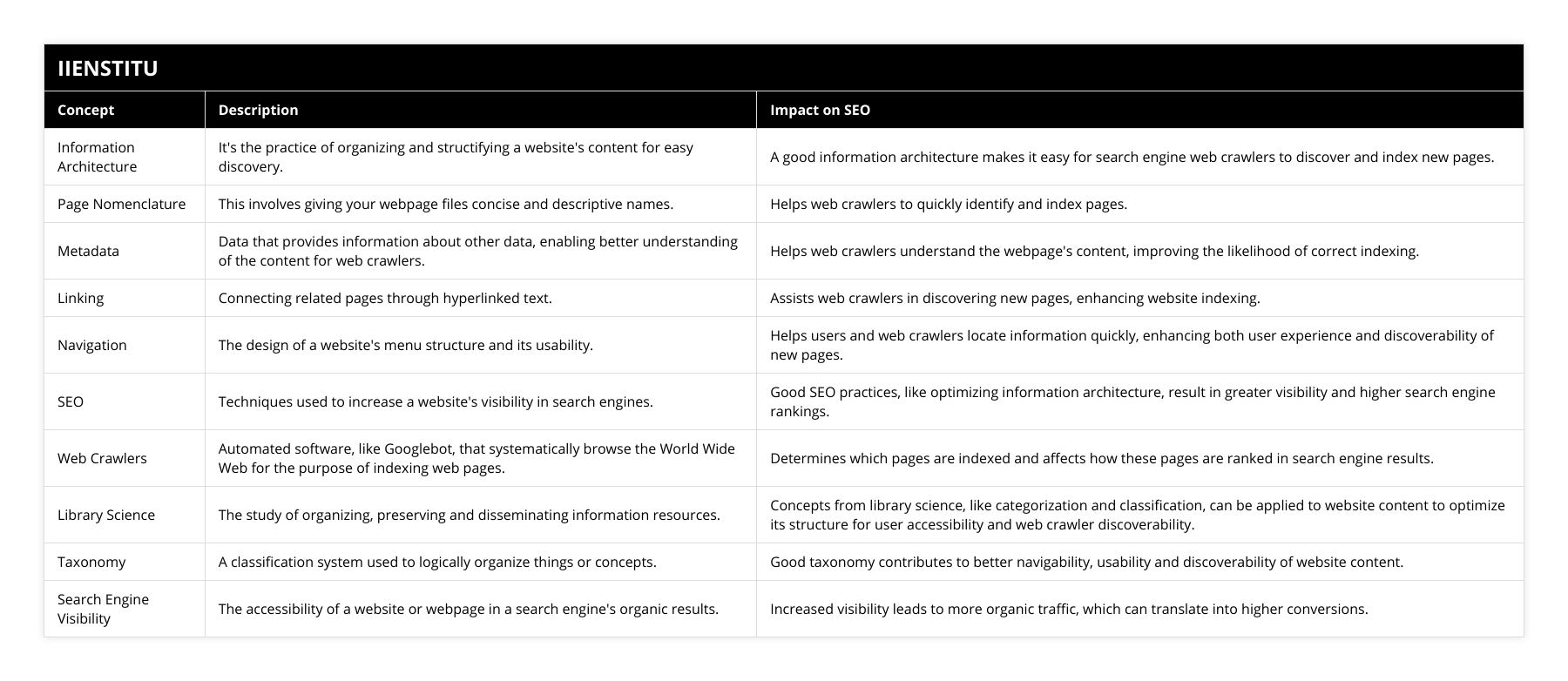
Frequently Asked Questions
How does Information Architecture help optimize SEO?
Search engine optimization (SEO) is crucial to any digital marketing strategy. Information architecture (IA) is a critical factor in SEO optimization, as it is responsible for the structure and organization of content on a website. This article will discuss the importance of IA for SEO, how it can be used to optimize SEO, and some tips to remember when creating a practical IA.
Information architecture is vital in SEO optimization because it determines how information is presented to users and how they will interact with the website. A well-structured IA can help improve a website’s visibility in search results and increase the chances of being found by potential customers. In addition, IA can be used to create a logical and intuitive navigation system, which can help users find the information they are looking for quickly and easily. This can result in higher engagement levels and a better user experience, which is essential for SEO optimization.
In addition to improving user experience, IA can also be used to optimize SEO. IA can organize and structure content in beneficial ways for SEO. For example, IA can create a hierarchy of pages, with the most important pages at the top. This can help search engines prioritize the most important pages in the search results. IA can also be used to create keyword-rich page titles, URLs, and page content, which can help improve the chances of ranking for those keywords.
Finally, here are some essential tips to remember when creating a practical IA. Firstly, creating a logical structure that is easy for users to navigate is critical. Secondly, creating keyword-rich page titles, URLs, and page content are necessary. Thirdly, ensuring that the IA is optimized for desktop and mobile devices is essential. Finally, it is required to regularly review the IA and make adjustments to ensure it is optimized for SEO.
In conclusion, information architecture plays a vital role in SEO optimization. It can be used to create a logical structure, improve user experience, and optimize SEO. It is important to remember to create a logical structure, create keyword-rich titles, URLs, and content, and optimize for both desktop and mobile devices. By following these tips, it is possible to develop a practical IA that can help improve SEO optimization.
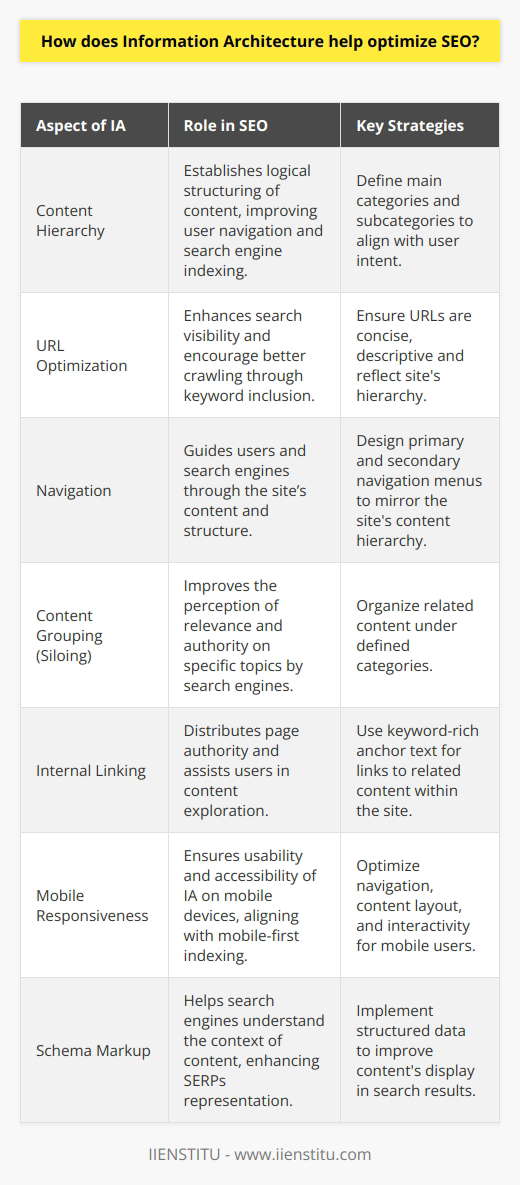
What strategies can be used to optimize Information Architecture for SEO?
Information architecture plays a crucial role when it comes to optimizing a website for search engine optimization (SEO). Information architecture, or IA, is the practice of organizing and structuring digital content so that it is easy to find and understand. It is an essential part of SEO because it helps search engines understand the website's purpose and what it has to offer. In this blog post, we will discuss strategies that can be used to optimize information architecture for SEO.
The first strategy is to create a logical and intuitive hierarchy of content. A website should be organized in a way that makes sense to visitors. This means that the main topics of the website should be easily identifiable, and the content should be organized into categories and sub-categories. This will help search engines understand the purpose of the website and its content and how the content is related.
The second strategy is to create a straightforward navigation structure. A website should be organized to make it easy for visitors to find the content they are looking for. This means the navigation should be straightforward, with links to the most important pages and categories. It is also important to include clear labels for navigation links, as this will help search engines understand the purpose of the website and content.
The third strategy is to include relevant keywords in the page titles and descriptions. Keywords are words or phrases related to the website's topic and are used by search engines to determine the relevance of a website. By including relevant keywords in the page titles and descriptions, search engines will better understand the website's content and purpose.
Finally, ensuring that the website is optimized for mobile devices is essential. As more people use mobile devices to access the internet, websites must be optimized for mobile use. This means that the content should be designed to be easily readable and viewable on mobile devices, and the navigation should be optimized for touch-based devices.
By following these strategies, website owners can ensure that their websites are optimized for SEO. By creating a logical and intuitive hierarchy of content, including relevant keywords in the page titles and descriptions, and optimizing the website for mobile devices, website owners can help search engines understand the website's purpose and content and rank it higher in search engine results.

How does thinking of websites as libraries help with SEO?
In recent years, conceptualizing websites as libraries has become increasingly popular among web designers and content creators. This website design and content creation approach are beneficial regarding search engine optimization (SEO). By understanding how the thinking of websites as libraries can help with SEO, web designers, and content creators can better optimize their websites to maximize their visibility in search engine results.
First, it is essential to recognize that search engines like Google use complex algorithms to determine the importance of a website and its content. These algorithms consider various elements when assessing a website, including the amount of content, quality, and how the content is organized. By thinking of websites as libraries, web designers and content creators can optimize their websites to ensure that their content is organized in a manner that is both logical and easily understood by search engine algorithms.
Furthermore, thinking of websites as libraries can also help with SEO by providing a structure that encourages content creators to add more content to their websites. By having a clearly defined system, content creators can quickly identify areas where they can add more content and thus improve the quality and quantity of their website’s content. This, in turn, can help ensure that search engine algorithms prioritize a website's content over that of its competitors.
Finally, it is essential to note that the concept of thinking of websites as libraries can also help with SEO by providing a platform for content creators to engage in backlinking. By including relevant links to external sources in their content, content creators can help to improve the perceived relevance of their website’s content and thus improve their website’s ranking in search engine results.
In conclusion, viewing websites as libraries can be a powerful tool for web designers and content creators to optimize their websites for search engine optimization. By understanding how thinking of websites as libraries can help with SEO, web designers, and content creators can better optimize their websites to maximize their visibility in search engine results.

Why is information architecture important for SEO?
Information Architecture and SEO
Information architecture (IA) has a critical role in Search Engine Optimization (SEO). It primarily deals with organizing, structifying, and labeling website content to enhance usability and findability. A well-planned IA can easily guide users and search engine crawlers through the website.
Website Crawlability
The structure and organization of a website directly affect its crawlability—how search engine spiders browse and index the site. A logically organized site helps these crawlers navigate smoothly, improving the website's visibility on search engine result pages.
User Experience
IA also significantly influences the user experience. It simplifies users' search for desired content. Easy navigation indirectly contributes to SEO as it increases the time users spend on the site, reducing bounce rates.
Keyword Optimization
Additionally, a well-defined IA allows effective placement and repetition of keywords. It enables more precise and relevant content, a factor highly appreciated by search engines. This increases the chances of the website gaining a higher ranking.
Interlinking
IA allows for efficient use of internal linking. Relevant links lead users to additional crucial information within the same site. This not only enhances the user experience, but also promotes pages to search engine crawlers, improving their visibility.
IA, therefore, has real potential to make or break a website's SEO. Its strategic usage can lead to enhanced visibility, usability, and ultimately, the website’s SEO-economic success. Hence, understanding and effectively implementing IA is crucial for SEO.

What is information architecture in SEO?
Introduction to Information Architecture in SEO
Information Architecture (IA) fundamentally refers to the organization and structure of a website. It focuses on how information on the website is grouped, linked, and presented to users. In the context of Search Engine Optimization (SEO), it carries a substantial role.
Deepening Understanding of IA
In SEO, IA aids in determining the user flow through a website. It’s a blueprint of how different website sections interconnect, impacting how search engines index the site's pages. Correctly implemented, it can improve site usability and discoverability.
The IA-SEO Interplay
The role of IA in SEO is twofold. Firstly, it helps search engines understand the content hierarchy, making indexing more efficient. Secondly, a well-structured site increases user satisfaction, indirectly enhancing search engine rankings.
SEO Considerations in IA
When establishing an IA, there are specific SEO considerations. URL structure, sitemap, and internal linking should be part of IA decisions because they help search engines crawl the site efficiently.
Gravity of User-Friendly IA
Furthermore, an IA that optimizes usability and user experience boosts organic traffic, reduces bounce rates, and enhances dwell time. These factors indirectly influence SEO, as search engines favor sites that cater to such user behavior.
Benefits of IA in SEO
A well-planned IA can lead to more efficient crawling and better indexing by search engines. Additionally, it boosts user experience, which indirectly increases search engine rankings, ultimately resulting in improved site visibility and traffic.
In summary, information architecture plays a pivotal role in SEO. Smartly structuring a website can have significantly positive impacts, ranging from improved search engine indexing to enhanced user satisfaction and boosting SEO. Having a comprehensive understanding and strategic application of information architecture can elevate a site's SEO success.
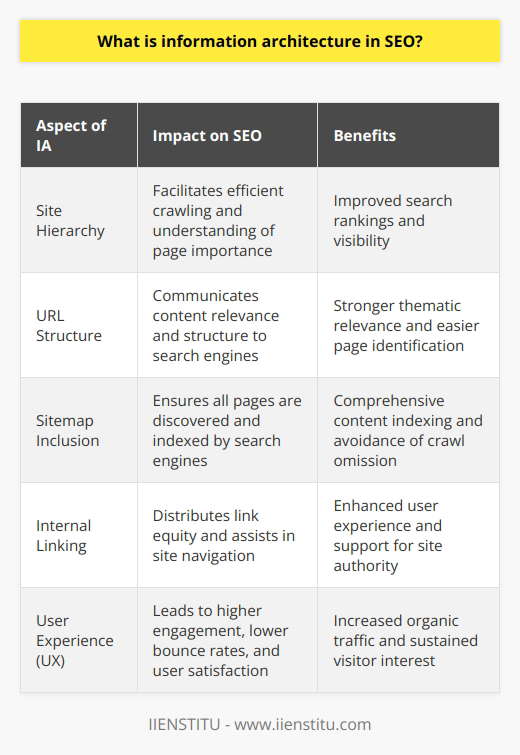
What is the purpose of SEO?
Understanding SEO
SEO or Search Engine Optimization serves a critical role in the digital marketplace. The fundamental purpose of SEO is to enhance a website's visibility in organic, or non-paid, search engine results.
Increasing Website Traffic
This increased visibility then drives more traffic to the website. As SEO improves a website's ranking position on search engine result pages (SERPs), it naturally attracts more online users, leading to improved quality in both quantity and traffic.
User Experience Improvement
Another key objective of SEO is improving the user experience. A site optimized for SEO adopts a mobile-friendly design, fast loading speeds, and high-quality, relevant content, which contribute to an optimal user experience.
Credibility and Trust Building
Building credibility and trust is another essential role of SEO. Websites appearing on the first page of search results generally gain more trust from users. A strategic SEO approach that includes creating quality backlinks, updating content regularly, and ensuring website security can significantly enhance a site's credibility.
Insight into Customers' Behavior
Lastly, SEO offers valuable insights into customer behavior. Effective SEO strategies incorporate tools such as Google Analytics that provide a wealth of information about the demographic, interests, and behaviors of a site's visitors. Businesses can use these insights to make informed marketing decisions and to refine their products and services.
In conclusion, SEO is not simply about getting the top spot on search result pages, but it is also about maintaining a user-friendly website, establishing trust and credibility, and gaining valuable insights to better serve customers. Without a robust SEO strategy, even the most well-designed and informative websites risk becoming invisible in the vast digital landscape.

How does a solid information architecture improve site visibility in search engines?
A Positive Impact on Organic Search Results
Solid information architecture has a profound influence on site visibility in search engines primarily because it makes a website more accessible and easier to understand. Well-structured sites allow search engines to easily crawl and index the content, increasing organic search results.
Enhancement of User Experience
Appropriate information architecture not only helps the search engine but also improves user experience. It guides users through the website quickly and efficiently, making the content more engaging and keeping users on the site longer. This can increase page views and interaction, which search engines see as signs of a quality website.
Incorporation of Effective Keywords and Links
Another essential aspect of information architecture is that it aids in the strategic use of keywords and links. Proper use of these elements is critical in improving search engine visibility. It increases the website's relevance to the search queries, which in return enhances the site's ranking.
Influence over Bounce Rate
With a robust information architecture, websites can also reduce their bounce rate, defined as the ratio of users who leave after viewing only one page. Lower bounce rates increase visibility as search engines interpret this as a quality indicator for user experience.
SEO Optimization
In conclusion, an effective information architecture contributes to SEO optimization by making the website more searchable, enhancing user experience, incorporating keywords and links, and reducing bounce rates. All these factors collaboratively enhance a site's visibility in search engines. Therefore, businesses and website developers should invest time and effort into developing a solid information architecture.

What are the essential components of an effective site information architecture for optimizing SEO?
Understanding Site Information Architecture
An effective site information architecture is pivotal in optimizing Search Engine Optimization (SEO). It is the blueprint that guides users and search engines through a website's content.
Site Structure
A well-structured site facilitates easy navigation, improves user experience, and enhances both the crawlability and indexability of a website. This architecture should place the most important pages close to the homepage, as it helps boost their SEO ranking.
URL Structure
URLs need to be neat and descriptive, with an appropriate use of keywords. A cleanly constructed URL improves users' understanding of web content, makes the website user-friendly, and impacts SEO.
Internal Linking
Proper internal linking is essential. By spreading link equity across the website, it helps search engine spiders discover and index new pages, and boosts the ranking potential of lower-level pages.
Navigation
Smooth, intuitive navigation helps users stay longer, decreases bounce rates, and increases page views, thereby boosting SEO rankings. Including a 'breadcrumb' trail allows users to retrace their steps, enhancing usability.
Sitemap
A sitemap helps both users and search engines understand the layout of the website quickly. This overview of all the website's pages helps search engines index the website better.
Hierarchical organization
A hierarchy based structure provides a clear and logical place for every piece of content. Organizing content through headings and subheadings allows search engines to understand the core topic of each page thereby enhancing SEO.
Content labeling
Labels help users understand what type of information they will find on a given page. Clear, precise labels will improve findability, user experience and consequently, SEO.
In conclusion, a strong site architecture is dependent on key components like a well-planned site structure, URL structure, effective internal links, straightforward navigation, detailed sitemaps, hierarchical organization, and content labeling. When properly managed, these components can significantly boost the SEO ranking of a website and provide a seamless user experience.
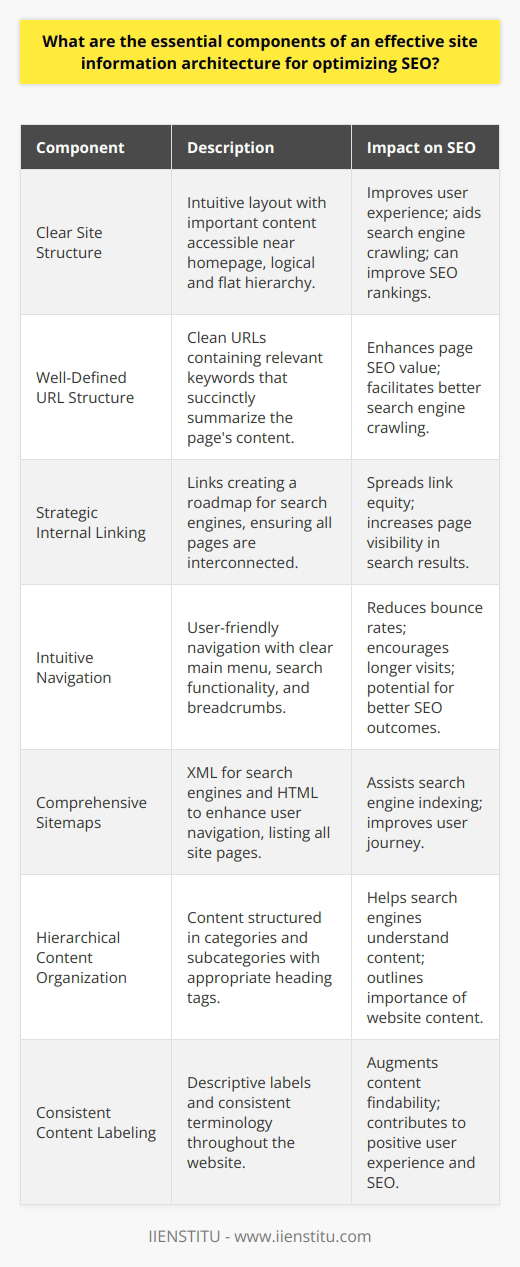
How can information architecture best practices be implemented to enhance overall SEO performance?
Understanding Information Architecture
Information architecture (IA) is key for efficient website navigation. It focuses on organizing and labeling online content to enhance user experience.
Using IA for SEO Enhancement
Meticulous implementation of IA practices can enhance overall SEO performance. Firstly, a well-structured website informs search engine algorithms about the information hierarchy, reflecting on page rankings.
Categorization and Labeling
Strategic categorization and labeling, part of IA, make it easy for users and search engines to find content. Proper use of keywords in labels and category names significantly aids SEO.
Importance of URL Structure
A clean, readable URL structure further aids SEO. URLs should mirror the site hierarchy and contain relevant keywords, improving site visibility.
Site Navigation and Internal Linking
An intuitive site navigation, fostered by robust IA, keeps users longer on site, reducing bounce rates. Similarly, internal linking can guide crawlers and users to more detailed pages, increasing site indexability.
Effective Sitemap
The creation of a clear, detailed sitemap is paramount for SEO. It serves as a guide for search engine crawlers to understand and index site content.
XML vs HTML Sitemaps
XML sitemaps cater to search engines, whereas HTML benefits users. Both are crucial, serving different roles in an effective IA strategy aligning with SEO targets.
IA Audit and User Feedback
Constant IA auditing is necessary to identify potential improvements. Regular user feedback helps evaluate whether the IA meets the users' needs, further contributing to SEO.
In conclusion, incorporating IA best practices in a website design can noticeably enhance the overall SEO performance. Through improved site navigation and structure, user experience and search engine rankings see substantial growth. By ensuring that websites align with these principles, businesses can achieve better visibility and growth.
